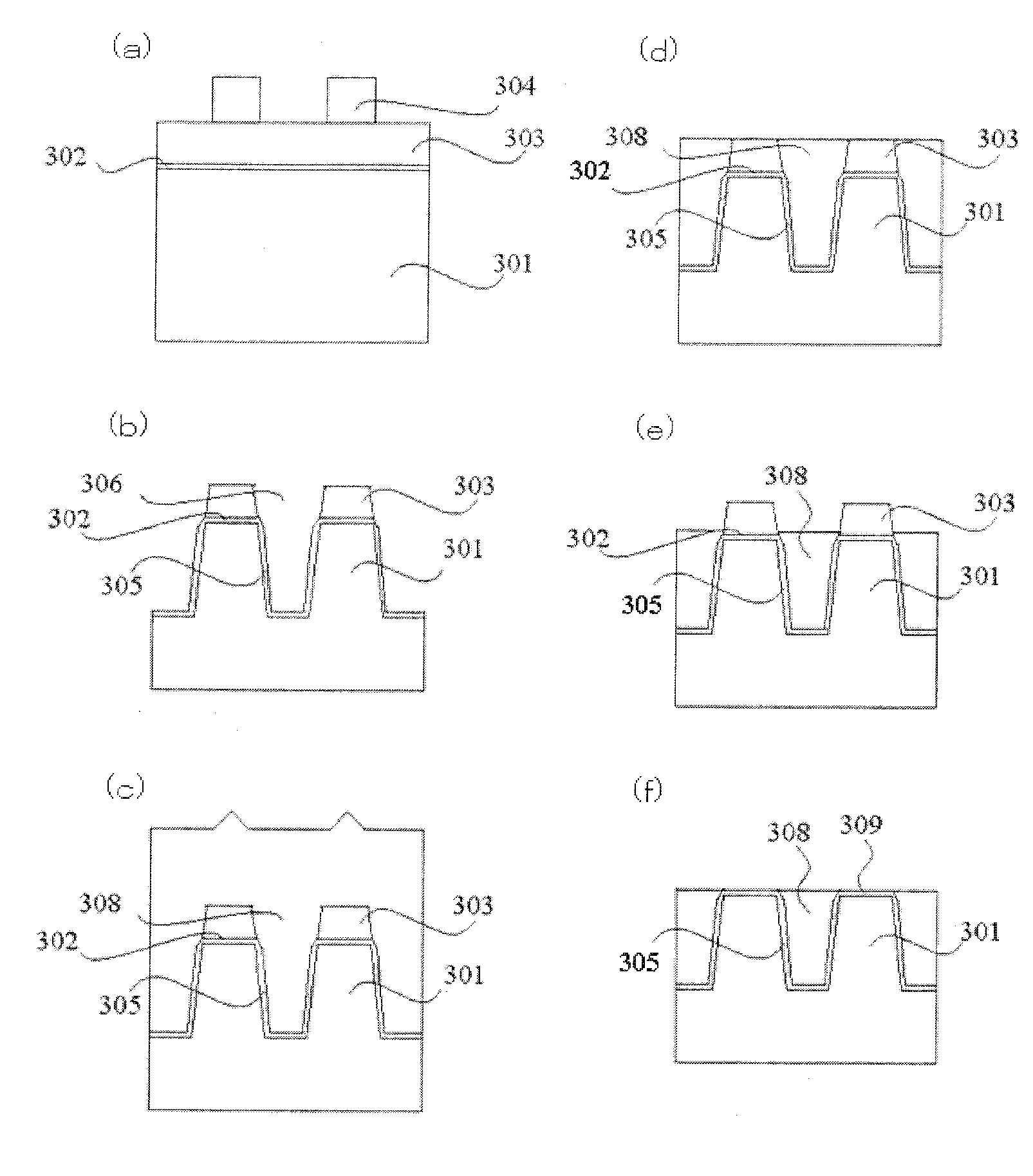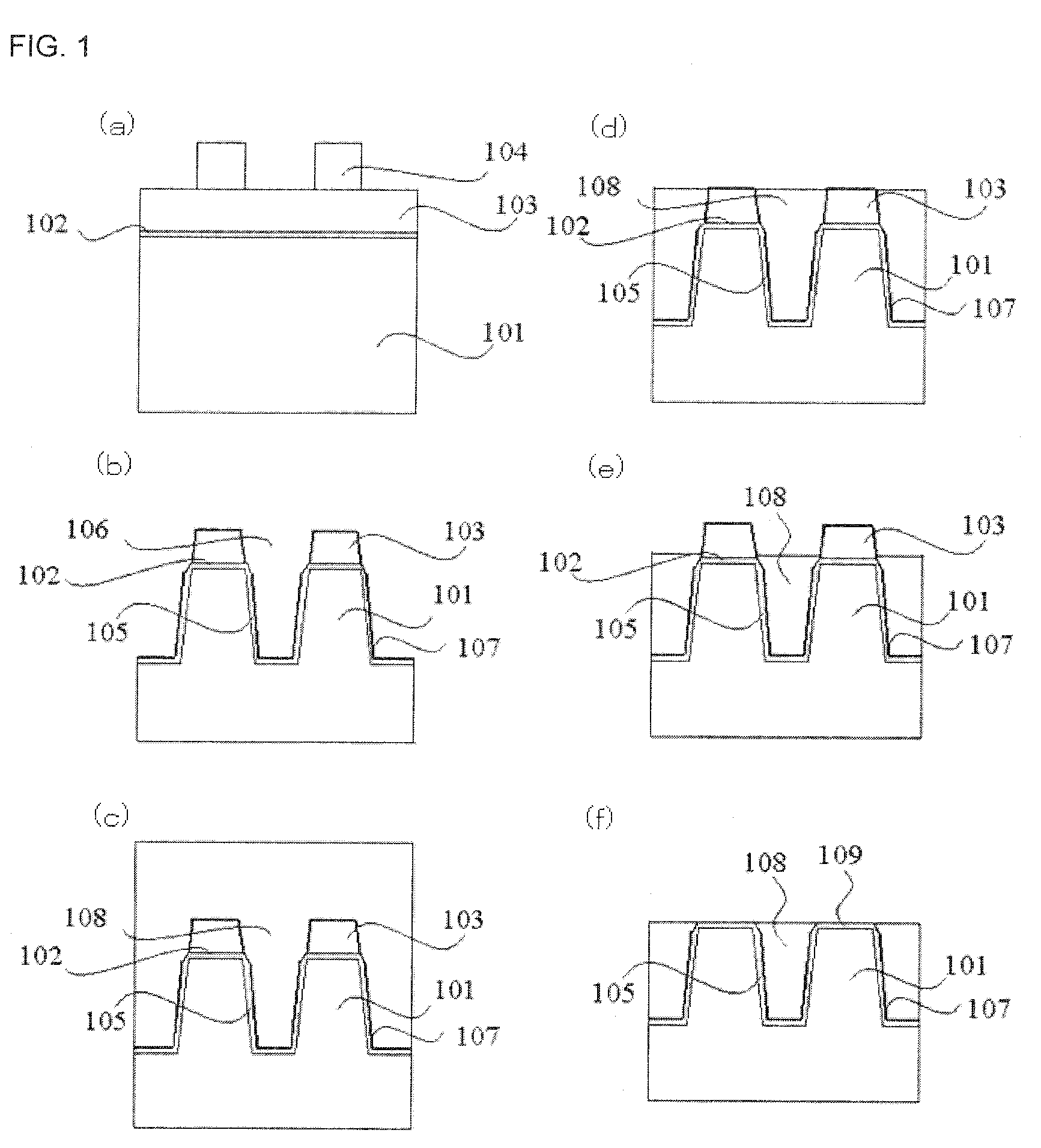Coating composition for forming oxide film and method for producing semiconductor device using the same
a technology of coating composition and oxide film, which is applied in the direction of coatings, electrical appliances, basic electric elements, etc., can solve the problems of no success in improving the hardware of deposition apparatuses, reducing yield, and reducing the width of etching, so as to suppress the phenomenon of increased wet etching rate, low level, and low cost
- Summary
- Abstract
- Description
- Claims
- Application Information
AI Technical Summary
Benefits of technology
Problems solved by technology
Method used
Image
Examples
example 1
[0066]In Example 1, a device isolation region (STI) was formed on a semiconductor substrate using a coating composition for forming an oxide film which was a mixture of a polysilazane and a polysilane.
[0067]First, on a semiconductor substrate 101, a pad oxide film 102 (thickness: 9 nm) was formed by thermal oxidation and a nitride film 103 (thickness: 120 nm) was formed by LP-CVD. A pattern of photoresist 104 was formed on the nitride film 103 using a known lithography technique (FIG. 1(a)).
[0068]Next, with the photoresist 104 as a mask, the nitride film 103 and the pad oxide film 102 were patterned using a known etching technique. Then, the photoresist 104 was removed by ashing or the like in an oxygen plasma atmosphere. Next, with the patterned nitride film 103 as a mask, the semiconductor substrate 101 was etched to form a trench 106 (depth: about 180 nm) for device isolation. At this stage, the nitride film 103 was etched so that the thickness decreased from the original 120 nm ...
example 2
[0076]In Example 2, a gate interlayer dielectric film was formed using a coating composition for forming an oxide film which was a mixture of a polysilazane and a polysilane.
[0077]First, a gate interlayer dielectric film 202 was formed on a semiconductor substrate 201 having a formed device isolation region (not shown) such as STI. Next, a polysilicon 203 was formed on the gate interlayer dielectric film 202, and a metal electrode 204 of tungsten (W) or the like was formed on the polysilicon 203. It is noted that some works were carried out to suppress the interfacial resistance of a silicide and the like between the polysilicon 203 and the metal electrode 204. Further, a CVD nitride film 205 was formed on the metal electrode 204 (FIG. 2(a)).
[0078]Next, the CVD nitride film 205 and the metal electrode 204 were patterned using a known lithography technique and an etching technique (FIG. 2(b)).
[0079]Next, a nitride film 206 for preventing metal scattering was formed over the whole sur...
example 3
[0084]In Example 3, a device isolation region (STI) was formed on a semiconductor substrate using a coating composition for forming an oxide film which was a mixture of a hydrogenated silsesquioxane and a polysilane. Here, the method was carried out in the same manner as in Example 1, except that a solution prepared by mixing Type-12 (trade name; a hydrogenated silsesquioxane manufactured by Tokyo Ohka Kogyo Co., Ltd.) with cyclopentasilane in the same amount was used as the coating composition for forming an oxide film.
[0085]When this coating composition for forming an oxide film was coated on a non-patterned silicon substrate, then irradiated with UV light and subjected to a heat treatment, the volume change from after the baking of the formed film to after the thermal oxidation treatment was −3%. The oxide film embedded in the space portion between the gates formed thereby had an etching rate with hydrofluoric acid of roughly 1.1 times of the non-space portion (upper part of the ...
PUM
| Property | Measurement | Unit |
|---|---|---|
| thickness | aaaaa | aaaaa |
| thickness | aaaaa | aaaaa |
| depth | aaaaa | aaaaa |
Abstract
Description
Claims
Application Information
 Login to View More
Login to View More - R&D
- Intellectual Property
- Life Sciences
- Materials
- Tech Scout
- Unparalleled Data Quality
- Higher Quality Content
- 60% Fewer Hallucinations
Browse by: Latest US Patents, China's latest patents, Technical Efficacy Thesaurus, Application Domain, Technology Topic, Popular Technical Reports.
© 2025 PatSnap. All rights reserved.Legal|Privacy policy|Modern Slavery Act Transparency Statement|Sitemap|About US| Contact US: help@patsnap.com



